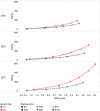The economic costs of planting, preserving, and managing the world's forests to mitigate climate change
- PMID: 33262324
- PMCID: PMC7708837
- DOI: 10.1038/s41467-020-19578-z
The economic costs of planting, preserving, and managing the world's forests to mitigate climate change
Abstract
Forests are critical for stabilizing our climate, but costs of mitigation over space, time, and stakeholder group remain uncertain. Using the Global Timber Model, we project mitigation potential and costs for four abatement activities across 16 regions for carbon price scenarios of $5-$100/tCO2. We project 0.6-6.0 GtCO2 yr-1 in global mitigation by 2055 at costs of 2-393 billion USD yr-1, with avoided tropical deforestation comprising 30-54% of total mitigation. Higher prices incentivize larger mitigation proportions via rotation and forest management activities in temperate and boreal biomes. Forest area increases 415-875 Mha relative to the baseline by 2055 at prices $35-$100/tCO2, with intensive plantations comprising <7% of this increase. Mitigation costs borne by private land managers comprise less than one-quarter of total costs. For forests to contribute ~10% of mitigation needed to limit global warming to 1.5 °C, carbon prices will need to reach $281/tCO2 in 2055.
Conflict of interest statement
The authors declare no competing interests.
Figures



References
-
- Sedjo RA. Forests. Environment. 1989;31:14–20.
-
- Adams DM, Alig RJ, McCarl BA, Callaway JM, Winnett SM. Minimum cost strategies for sequestering carbon in forests. Land Econ. 1999;75:360–374. doi: 10.2307/3147183. - DOI
-
- Smith, P. et al. Agriculture, Forestry and Other Land Use (AFOLU). In:Climate Change 2014: Mitigation of Climate Change. Contribution of Working Group III to the Fifth Assessment Report of the Intergovernmental Panel on Climate Change (eds Edenhofer, O. et al.). (Cambridge University Press, Cambridge, United Kingdom and New York, NY, USA, 2014).
-
- IPCC. Global Warming of 1.5 C An IPCC Special Report on the Impacts of Global Warming of 1.5 C Above Pre-Industrial Levels and Related Global Greenhouse Gas Emission Pathways, in the Context of Strengthening the Global Response to the Threat of Climate Change. Sustainable Development, and Efforts to Eradicate Poverty. https://www.ipcc.ch/sr15/. Vol. 1 (2019).
-
- IPCC. Climate Change and Land: An IPCC Special Report on Climate Change, Desertification, Land Degradation, Sustainable Land Management, Food Security, and Greenhouse Gas Fluxes in Terrestrial Ecosystems: Chapter 1: Framing and Context (2019).
LinkOut - more resources
Full Text Sources

